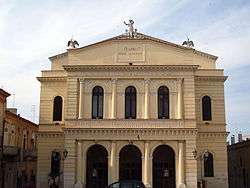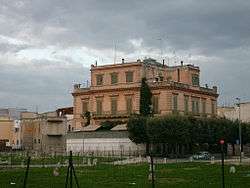Cerignola
| Cerignola | |
|---|---|
| Comune | |
| Comune di Cerignola | |
 Chiesa del Carmine in Cerignola | |
.svg.png) Cerignola within the Province of Foggia | |
 Cerignola Location of Cerignola in Italy | |
| Coordinates: 41°16′N 15°54′E / 41.267°N 15.900°ECoordinates: 41°16′N 15°54′E / 41.267°N 15.900°E | |
| Country | Italy |
| Region | Apulia |
| Province | Foggia (FG) |
| Frazioni | Angeloni, Borgo Libertà, Borgo Tressanti, Cerignola Campagna, La Pila, Montaltino, Moschella, Posta Incorvera, Posta Uccello, Pozzo Terraneo, Salice, San Giovanni in Fonte, San Michele delle Vigne, Tannioa |
| Government | |
| • Mayor | Francesco Metta |
| Area | |
| • Total | 593.71 km2 (229.23 sq mi) |
| Elevation | 120 m (390 ft) |
| Population (30 November 2017)[1] | |
| • Total | 58,534 |
| • Density | 99/km2 (260/sq mi) |
| Demonym(s) | Cerignolani |
| Time zone | UTC+1 (CET) |
| • Summer (DST) | UTC+2 (CEST) |
| Postal code | 71042 |
| Dialing code | 0885 |
| Patron saint | Madonna of Ripalta |
| Saint day | September 8 |
| Website | Official website |


Cerignola (Italian pronunciation: [tʃeriɲˈɲɔːla]; Cerignolano: Ceregnòule [tʃərəɲˈɲɔwlə] (![]()
Geography
The large municipality of Cerignola is located on the Tavoliere plain, in south of its province, and spans from the Salt Marshes of Margherita di Savoia to the borders with Basilicata region. It borders with Ascoli Satriano, Canosa di Puglia, Carapelle, Lavello, Manfredonia, Ordona, Orta Nova, San Ferdinando di Puglia, Stornara, Stornarella, Trinitapoli and Zapponeta.[2]
History
Cerignola occupies the site of Furfane, a station on the ancient Roman Via Traiana between Canusium and Herdoniae.
It was a municipium during the Roman Empire. In the Middle Ages, as part of the Kingdom of Naples, in 1418 it become a fief of the Caracciolo family.
In 1503 the Spaniards under Gonzalo de Córdoba defeated the French under Louis d'Armagnac (6th Duke of Nemours) below the town, a victory which ensured Spain the rule over the kingdom of Naples (see battle of Cerignola) and is considered the first battle whose outcome was determined by gunpowder.[3]
In 17th century the fief passed to the Pignatelli family. Cerignola was rebuilt after a great earthquake in 1731. In the 19th century, after the reclamation of its territory, it has been home to a considerable agricultural production.
Main sights
- The Cathedral
- The Chiesa Madre of St. Francis of Assisi (11th-12th centuries)
- Torre Alemanna (13th century), in the frazione Borgo Libertà
- Church of Beata Vergine del Monte Carmelo (16th century)
- Palazzo Cirillo-Farrusi
- Piano delle Fosse del Grano
Cuisine
The Italian wine DOC of Rosso di Cerignola is designated for red wine production only. Grapes are limited to a harvest yield of 14 tonnes/ha with the finished wine required to have at least 12% alcohol. The wine is a blend of at least 55% Uva di Troia, 15-30% Negroamaro, and up to 15% of an assortment of Sangiovese, Barbera, Montepulciano, Malbec and Trebbiano. If the wine is labeled as Riserva then the wine must have been aged at least two years in oak barrels/wood with a minimum alcohol level of 13%.[4]
Transportation
Cerignola has a station, Cerignola Campagna, on the Pescara-Bari main railroad (Adriatic railway), served by regional trains. From 1891 to 1956, it was the terminus of a short line to the city centre (Cerignola Città station).[5]
It has also an exit ("Cerignola Est") on the A14 motorway Bologna-Taranto, and one ("Cerignola Ovest") on the A16 motorway Naples-Canosa. Provincial roads connect it to the main centre in the region as well.
Public bus service in the town is provided by STUC company.
People
Cerignola is the native town of philologist Nicola Zingarelli, founder of the Zingarelli Italian dictionary, and syndicalist Giuseppe Di Vittorio. Achille La Guardia, father of Fiorello LaGuardia, Mayor of New York, originated from here.
Sport
The local football team is the Audace Cerignola, and its home ground is the Domenico Monterisi Stadium.[6]
International relations
Cerignola is twinned with:
See also
References
- 1 2 (in Italian) Source: Istat 2017
- ↑ 41120 41120 on OpenStreetMap
- ↑ Wootton, David (2015). The Invention of Science: A New History of the Scientific Revolution. E-book: HarperCollins. pp. Kindle Location 1216. ISBN 978-0-06-175952-9.
- ↑ P. Saunders Wine Label Language pg 196 Firefly Books 2004 ISBN 1-55297-720-X
- ↑ see Commons' map
- ↑ (in Italian) Audace Cerignola official website
Sources
![]()
External links
| Wikimedia Commons has media related to Cerignola. |
- Official website (in Italian)
- La Notizia Web - Cerignola's online newspaper (in Italian)
